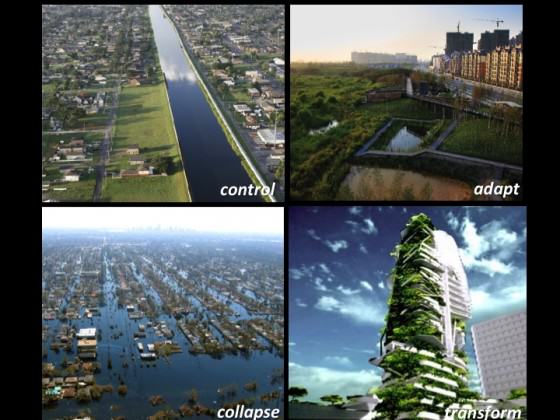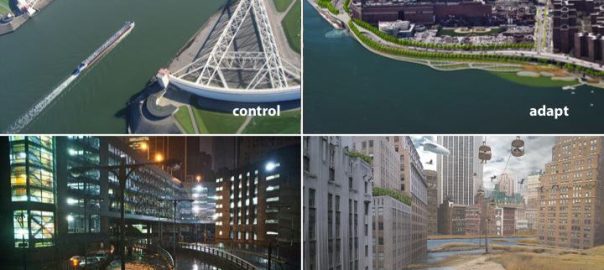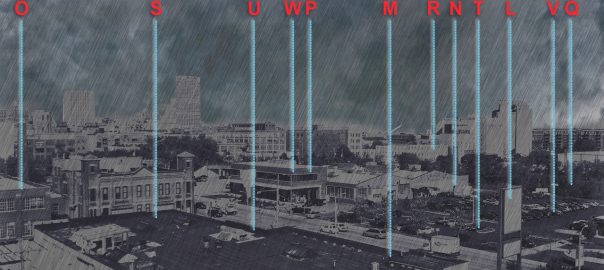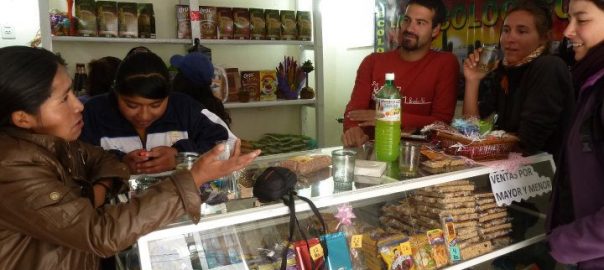This essay is adapted from Marina Alberti Cities as Hybrid Ecosystems (Forthcoming) and from Marina Alberti “Anthropocene City”, forthcoming in The Anthropocene Project by the Deutsche Museum Special Exhibit 2014-1015
Cities face an important challenge: they must rethink themselves in the context of planetary change. What role do cities play in the evolution of Earth? From a planetary perspective, the emergence and rapid expansion of cities across the globe may represent another turning point in the life of our planet. Earth’s atmosphere, on which we all depend, emerged from the metabolic process of vast numbers of single-celled algae and bacteria living in the seas 2.3 billion years ago. These organisms transformed the environment into a place where human life could develop. Adam Frank, an Astrophysicist at the University of Rochesters, reminds us that the evolution of life has completely changed big important characteristics of the planet (NPR 13.7: Cosmos & Culture, 2012). Can humans now change the course of Earth’s evolution? Can the way we build cities determine the probability of crossing thresholds that will trigger non-linear, abrupt change on a planetary scale (Rockström et al 2009)?
For most of its history, Earth has been relatively stable, and dominated primarily by negative feedbacks that have kept it from getting into extreme states (Lenton and Williams 2013). Rarely has the earth experienced planetary-scale tipping points or system shifts. But the recent increase in positive feedback (i.e., climate change), and the emergence of evolutionary innovations (i.e. novel metabolisms), could trigger transformations on the scale of the Great Oxidation (Lenton and Williams 2013). Will we drive Earth’s ecosystems to unintentional collapse? Or will we consciously steer the Earth towards a resilient new era?
In my forthcoming book, Cities as Hybrid Ecosystems, I propose a co-evolutionary paradigm for building a science of cities that “think like planets” (see the Note at the bottom)— a view that focuses both on unpredictable dynamics and experimental learning and innovation in urban ecosystems. In the book I elaborate on some concepts and principles of design and planning that can emerge from such a perspective: self-organization, heterogeneity, modularity, feedback, and transformation.
How can thinking on a planetary scale help us understand the place of humans in the evolution of Earth and guide us in building a human habitat of the “long now”?
Planetary Scales
Humans make decisions simultaneously at multiple time and spatial scales, depending on the perceived scale of a given problem and scale of influence of their decision. Yet it is unlikely that this scale extends beyond one generation or includes the entire globe. The human experience of space and time has profound implications for our understanding of world phenomena and for making long- and short-term decisions. In his book What time is this place, Kevin Lynch (1972) eloquently told us that time is embedded in the physical world that we inhabit and build. Cities reflect our experience of time, and the way we experience time affects the way we view and change the environment. Thus our experience of time plays a crucial role in whether we succeed in managing environmental change. If we are to think like a planet, the challenge will be to deal with scales and events far removed from everyday human experience. Earth is 4.6 billion years old. That’s a big number to conceptualize and account for in our individual and collective decisions.
Thinking like a planet implies expanding the time and spatial scales of city design and planning, but not simply from local to global and from a few decades to a few centuries. Instead, we will have to include the scales of the geological and biological processes on which our planet operates. Thinking on a planetary scale implies expanding the idea of change. Lynch (1972) reminds us that “the arguments of planning all come down to the management of change.” But what is change?
Human experience of change is often confined to fluctuations within a relatively stable domain. However Planet Earth has displayed rare but abrupt changes and regime shifts in the past. Human experience of abrupt change is limited to marked changes in regional system dynamics, such as altered fire regimes, and extinctions of species. Yet, since the Industrial Revolution, humans have been pushing the planet outside a stability domain. Will human activities trigger such a global event? We can’t answer that, as we don’t understand enough about how regime shifts propagate across scales, but emerging evidence does suggest that if we continue to disrupt ecosystems and climate we face an increasing risk of crossing those thresholds that keep the earth in a relatively stable domain. Until recently our individual behaviors and collective institutions have been shaped primarily by change that we can envision relatively easily on a human time scale. Our behaviors are not tuned to the slow and imperceptible but systematic changes that can drive dramatic shifts in Earth’s systems.
Planetary shifts can be rapid: the glaciation of the Younger Dryas (abrupt climatic change resulting in severe cold and drought) occurred roughly 11,500 years ago, apparently over only a few decades. Or, it can unfold slowly: the Himalayas took over a million years to form. Shifts can emerge as the results of extreme events like volcanic eruptions, or relatively slow processes, like the movement of tectonic plates. Though we still don’t completely understand the subtle relationship between local and global stability in complex systems, several scientists hypothesize that the increasing complexity and interdependence of socio-economic networks can produce ‘tipping cascades’ and ‘domino dynamics’ in the Earth’s system, leading to unexpected regime shifts (Helbing 2013, Hughes et al 2013).
Planetary Challenges and Opportunities
A planetary perspective for envisioning and building cities that we would like to live in—cities that are livable, resilient, and exciting—provides many challenges and opportunities. To begin, it requires that we expand the spectrum of imaginary archetypes. Current archetypes reflect skewed and often extreme simplifications of how the universe works, ranging from biological determinism to techno-scientific optimism. At best they represent accurate but incomplete accounts of how the world works. How can we reconcile the messages contained in the catastrophic versus optimistic views of the future of Earth? And, how can we hold divergent explanations and arguments as plausibly true? Can we imagine a place where humans have co-evolved with natural systems? What does that world look like? How can we create that place in the face of limited knowledge and uncertainty, holding all these possible futures as plausible options?

The concept of “planetary boundaries” offers a framework for humanity to operate safely on a planetary scale. Rockström et al (2009) developed the concept of planetary boundaries to inform us about the levels of anthropogenic change that can be sustained so we can avoid potential planetary regime shifts that would dramatically affect human wellbeing. The concept does not imply, and neither rules out, planetary-scale tipping points associated with human drivers. Hughes et al (2013) do address some the misconception surrounding planetary-scale tipping points that confuses a system’s rate of change with the presence or absence of a tipping point. To avoid the potential consequences of unpredictable planetary-scale regime shifts we will have to shift our attention towards the drivers and feedbacks rather than focus exclusively on the detectable system responses. Rockström et al (2009) identify nine areas that are most in need of set planetary boundaries: climate change; biodiversity loss; input of nitrogen and phosphorus in soils and waters; stratospheric ozone depletion; ocean acidification; global consumption of freshwater; changes in land use for agriculture; air pollution; and chemical pollution.
A different emphasis is proposed by those scientists who have advanced the concept of planetary opportunities: solution-oriented research to provide realistic, context-specific pathways to a sustainable future (DeFries et al. 2012). The idea is to shift our attention to how human ingenuity can expand the ability to enhance human wellbeing (i.e. food security, human health), while minimizing and reversing environmental impacts. The concept is grounded in human innovation and the human capacity to develop alternative technologies, implement “green” infrastructure, and reconfigure institutional frameworks. The potential opportunities to explore solution-oriented research and policy strategies are amplified in an urbanizing planet, where such solutions can be replicated and can transform the way we build and inhabit the Earth.
Imagining a Resilient Urban Planet
While these different images of the future are both plausible and informative, they speak about the present more than the future. They all represent an extension of the current trajectory as if the future would unfold along the path of our current way of asking questions, and our way of understanding and solving problems. Yes, these perspectives do account for uncertainty but it is defined by the confidence intervals around this trajectory. Both stories are grounded in the inevitable dichotomies of humans and nature, and technology vs. ecology. These views are at best an incomplete account of what is possible: they reflect a limited ability to imagine the future beyond such archetypes. Why can we imagine smart technologies and not smart behaviors, smart institutions, and smart societies? Why think only of technology and not of humans and their societies that co-evolve with Earth?
Understanding the co-evolution of human and natural systems is key to build a resilient society and transform our habitat. One of the greatest questions in biology today is whether natural selection is the only process driving evolution and what the other potential forces might be. To understand how evolution constructs the mechanisms of life, molecular biologists would argue that we also need to understand the self-organization of genes governing the evolution of cellular processes and influencing evolutionary change (Johnson and Kwan Lam 2010).
To function, life on Earth depends on the close cooperation of multiple elements. Biologists are curious about the properties of complex networks that supply resources, process waste, and regulate the system’s functioning at various scales of biological organization. West et al. (2005) propose that natural selection solved this problem by evolving hierarchical fractal-like branching. Other characteristics of evolvable systems are flexibility (i.e. phenotypic plasticity), and novelty. This capacity for innovation is an essential precondition for any system to function. Gunderson and Holling (2002) have noted that if systems lack the capacity for innovation and novelty, they may become over-connected and dynamically locked, unable to adapt. To be resilient and evolve, they must create new structures and undergo dynamic change. Differentiation, modularity, and cross-scale interactions of organizational structures have been described as key characteristics of systems that are capable of simultaneously adapting and innovating (Allen and Holling 2010).
To understand coevolution of human-natural systems will require advancement in the evolution and social theories that explain how complex societies and cooperation have evolved. What role does human ingenuity play? In Cities as Hybrid Ecosystems I propose that coupled human-natural systems are not governed only by either natural selection or human ingenuity alone, but by hybrid processes and mechanisms. It is their hybrid nature that makes them unstable and at the same time able to innovate. This novelty of hybrid systems is key to reorganization and renewal. Urbanization modifies the spatial and temporal variability of resources, creates new disturbances, and generates novel competitive interactions among species. This is particularly important because the distribution of ecological functions within and across scales is key to the system being able to regenerate and renew itself (Peterson et al. 1998).
The city that thinks like a planet: What does it look like?
In this blog article I have ventured to pose this question, but I will not venture to provide an answer. In fact no single individual can do that. The answer resides in the collective imagination and evolving behaviors of people of diverse cultures who inhabit a diversity of places on the planet. Humanity has the capacity to think in the long term. Indeed, throughout history, people in societies faced with the prospect of deforestation, or other environmental changes, have successfully engaged in long-term thinking, as Jared Diamond (2005) reminds us: consider Tokugawa shoguns, Inca emperors, New Guinea highlanders, or 16th-century German landowners. Or, more recently, the Chinese. Many countries in Europe, and the United States, have dramatically reduced their air pollution and meanwhile increased their use of energy and combustion of fossil fuels. Humans have the intellectual and moral capacity to do even more when tuned into challenging problems and engaged in solving them.
A city that thinks like a planet is not built on already set design solutions or planning strategies. Nor can we assume that the best solution would work equally well across the world regardless of place and time. Instead, such a city will be built on principles that expand its drawing board and collaborative action to include planetary processes and scales, to position humanity in the evolution of Earth. Such a view acknowledges the history of the planet in every element or building block of the urban fabric, from the building to the sidewalk, from the back yard to the park, from the residential street to the highway. It is a view that is curious about understanding who we are and about taking advantage of the novel patterns, processes, and feedbacks that emerge from human and natural interactions. It is a city grounded in the here and the now and simultaneously in the different time and spatial scales of human and natural processes that govern the Earth. A city that thinks like a planet is simultaneously resilient and able to change.
How can such a perspective guide decisions in practice? Urban planners and decision makers, making strategic decisions and investments in public infrastructure, want to know whether certain generic properties or qualities of a city’s architecture and governance could predict its capacity to adapt and transform itself. Can such a shift in perspective provide a new lens, a new way to interpret the evolution of human settlements, and to support humans in successfully adapting to change? Evidence emerging from the study of complex systems points to their key properties that expand adaptation capacity while enabling them to change: self organization, heterogeneity, modularity, redundancy, and cross-scale interactions.
A co-evolutionary perspective shifts the focus of planning towards human-natural interactions, adaptive feedback mechanisms, and flexible institutional settings. Instead of predefining “solutions,” that communities must implement, such perspective focuses on understanding the ‘rules of the game’, to facilitate self-organization and careful balance top-down and bottom-up managements strategies (Helbing 2013). Planning will then rely on principles that expand heterogeneity of forms and functions in urban structures and infrastructures that support the city. They support modularity (selected as opposed to generalized connectivity) to create interdependent decentralized systems with some level of autonomy to evolve.
In cities across the world, people are setting great examples that will allow for testing such hypotheses. Human perception of time and experience of change is an emerging key in the shift to a new perspective for building cities. We must develop reverse experiments to explore what works, what shifts the time scale of individual and collective behaviors. Several Northern European cities have adopted successful strategies to cut greenhouse gases, and combined them with innovative approaches that will allow them to adapt to the inevitable consequences of climate change. One example is the Copenhagen 2025 Climate Plan. It lays out a path for the city to become the first carbon-neutral city by 2025 through efficient zero-carbon mobility and building. The city is building a subway project that will place 85 percent of its inhabitants within 650 yards of a Metro station. Nearly three-quarters of the emissions reductions will come as people transition to less carbon-intensive ways of producing heat and electricity through a diverse supply of clean energy: biomass, wind, geothermal, and solar. Copenhagen is also one of the first cities to adopt a climate adaptation plan to reduce its vulnerability to the extreme storm events and rising seas expected in the next 100 years.
In the Netherlands, alternative strategies are being explored to allow people to live with the inevitable floods. These strategies involve building on water to develop floating communities and engineering and implementing adaptive beach protections that take advantage of natural processes. The experimental Sand Motor project uses a combination of wind, waves, tides, and sand to replenish the eroded coasts. The Dutch Rijkswaterstaat and the South Holland provincial authority placed a large amount of sand in an artificial 1 km long and 2 km wide peninsula into the sea, allowing for the wave and currents to redistribute it and build sand dunes and beaches to protect the coast over time.
New York is setting an example for long-term planning by combining adaptation and transformation strategies into its plan to build a resilient city, and Mayor Michael Bloomberg has outlined a $19.5 billion plan to defend the city against rising seas. In many rapidly growing cities of the Global South, similar leadership is emerging. For example, Johannesburg which adopted one of the first climate change adaptation plan, and so have Durban and Cape Town, in South Africa and Quito, Equador, along with Ho Chi Minh City Vietnam, where a partnership with the City of Rotterdam Netherlands has been established to develop a resilience strategy.
To think like a planet and explore what is possible we may need to reframe our questions. Instead of asking what is good for the planet, we must ask what is good for a planet inhabited by people. What is a good human habitat on Earth? And instead of seeking optimal solutions, we should identify principles that will inform the diverse communities across the world. The best choices may be temporary, since we do not fully understand the mechanisms of life, nor can we predict the consequences of human action. They may very well vary with place and depend on their own histories. But human action may constrain the choices available for life on earth.
Scenario Planning
Scenario planning offers a systematic and creative approach to thinking about the future by letting scientists and practitioners expand old mindsets of ecological sciences and decision making. It provides a tool we can use to deal with the limited predictability of changes on the planetary scale and to support decision-making under uncertainty. Scenarios help bring the future into present decisions (Schwartz 1996). They broaden perspectives, prompt new questions, and expose the possibilities for surprise.
Scenarios have several great features. We expect that they can shift people’s attention toward resilience, redefine decision frameworks, expand the boundaries of predictive models, highlight the risks and opportunities of alternative future conditions, monitor early warning signals, and identify robust strategies (Alberti et al 2013)
A fundamental objective of scenario planning is to explore the interactions among uncertain trajectories that would otherwise be overlooked. Scenarios highlight the risks and opportunities of plausible future conditions. The hypothesis is that if planners and decision makers look at multiple divergent scenarios, they will engage in a more creative process for imagining solutions that would be invisible otherwise. Scenarios are narratives of plausible futures; they are not predictions. But they are extremely powerful when combined with predictive modeling. They help expand boundary conditions and provide a systematic approach we can use to deal with intractable uncertainties and assess alternative strategic actions. Scenarios can help us modify model assumptions and assess the sensitivities of model outcomes. Building scenarios can help us highlight gaps in our knowledge and identify the data we need to assess future trajectories.
Scenarios can also shine spotlights on warning signals, allowing decision makers to anticipate unexpected regime shifts and to act in a timely and effective way. They can support decision making in uncertain conditions by providing us a systematic way to assess the robustness of alternative strategies under a set of plausible future conditions. Although we do not know the probable impacts of uncertain futures, scenarios will provide us the basis to assess critical sensitivities, and identify both potential thresholds and irreversible impacts so we can maximize the wellbeing of both humans and our environment.
A new ethic for a hybrid planet
More than half a century ago, Aldo Leopold (1949) introduced the concept of “thinking like a mountain”: he wanted to expand the spatial and temporal scale of land conservation by incorporating the dynamics of the mountain. Defining a Land Ethic was a first step in acknowledging that we are all part of larger community hat include soils, waters, plants, and animals, and all the components and processes that govern the land, including the prey and predators. Now, along the same lines, Paul Hirsch and Bryan Norton in Ethical Adaptation to Climate Change: Human Virtues of the Future, (2012, MIT Press) articulate a new environmental ethics by suggesting that we “think like a planet.” Building on Hirsch and Norton’s idea, we need to expand the dimensional space of our mental models of urban design and planning to the planetary scale.
Marina Alberti
Seattle
Note: The metaphor of “thinking like a planet” builds on the idea of cognitive transformation proposed by Paul Hirsch and Bryan Norton (2012) In Ethical Adaptation to Climate Change: Human Virtues of the Future, MIT Press.











This is great, Marina, thanks for a well-formed introduction to this concept. Thinking like a planet is very catchy!
I find the four typologies you’ve selected as very evocative, and they are useful for offering a pragmatic image to an otherwise theoretical proposal. As ever, the big question mark will be wondering what the physical manifestation of this paradigm will actually look like (and I love your reference to all the sorts of impressions that might respond, like shoguns, highlanders and 16th century landowners). Additionally, where and how will it translate into design and planning streams, etc.
Perhaps your book will respond to these questions with insight. Looking forward to it!
Or – enabling humans to think like nature